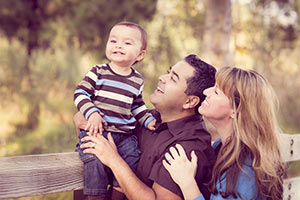ADOPTION IN
Texas

Texas adoption is one option for expectant parents facing an unplanned pregnancy or hopeful adoptive parents looking to build a forever family. You can navigate the adoption process in Texas with the help of the Adoption.com Team. Whether you’re looking for pregnancy support or you’re trying to get the word out about your interest in adopting, we can help you get started.
Adoption Near Me
Considering Placing Your Baby or Child for Adoption? You can learn more here or call an adoption counselor 1-800-236-7898.
Domestic Infant Adoptions can be completed through a Texas adoption agency or adoption attorney. Click
here for a directory of adoption service providers in Texas.
International Adoptions must be completed through an adoption agency or adoption attorney. Find an international adoption service provider here.
Foster Care Adoptions in Texas can be completed through the Department of Family and Protective Services.
Gallery of children waiting to be adopted.
Join the Texas adoption group in our community
Looking for more resources in your area? Check out the Adoption Directory for a listing of adoption professionals in your state.
I’m considering placing my baby or child for adoption.
Pregnant and have questions? We can help answer your questions by telling us what works best for you.
Are you pregnant and considering adoption? Do you need help getting started?
Click here and help us understand what your needs are and the preferences you have. We can help you get started.
Adoption in Texas
By: Lacy Davis, Birth Mother
Making the lifelong decision of choosing adoption for your child is a scary and foreign concept to many. Adoption in Texas is where I find my experience in my adoption journey. If you have found your way to this article, I commend you for even considering options regarding what truly is the best choice for your child’s life if you are not able to parent at this point in your life. Adoption is often considered a taboo subject, and there is sometimes not enough information available to help understand what exactly it can mean, and the details surrounding what the process can look like. This article is here to help give you an idea of what you might experience through this journey, although no adoption plan will ever look the same, and can be customized to what is right for you and your child. I am a birth mother who decided to place my child for adoption in Texas, and I would like to give you some insight into my journey as well as provide information to help give you an idea of what that choice could look like for you.
Choosing to Place A Baby For Adoption
There are no right or wrong reasons for thinking adoption might be best for your child. Finding yourself in an unsafe situation, lacking control of the kind of life you can provide for your child, or knowing you are not ready to become a parent can all be reasons you might consider adoption. It might be something that your family suggested, or it could be something you have no support from your family in but know it is right for you. There is also no one type of person that adoption might be right for. You could be a teenager with no education, no job, or no housing for yourself. You could be married with two children already, and know that another child is not something your family could take on at this time. You could be anything in between and still be finding yourself deciding if placing your child for adoption in Texas is right for you. I fell into the first category I mentioned. The only requirement for choosing to place your child for adoption is that it comes from a place of love for your child. When you begin wondering if this could be right for you, it is important to think about the factors that led you here and why you came to this decision. You can change your mind at any point in the decision up until the finalization of paperwork, but being secure in your reasons for making this choice can be helpful if you find yourself hesitating at any point down the road.
What Could My Adoption Look Like?
There are many different ways adoption can look, and it can seem overwhelming when starting the process. If you are considering adoption in Texas, choosing to place through an agency can help have the support to manage the personal, legal, and emotional aspects. Using an agency will provide you with a caseworker who will not only help you navigate your choices pre-placement but will continue to offer support and guidance during post-placement as well. There are different agencies available for different types of adoption, but for my private domestic adoption, I used The Gladney Center for Adoption.
Once you choose an agency, those professionals can help you figure out if you would like to have an open adoption, semi-open adoption, closed adoption, or a variation on any of these. These terms describe the amount of interaction you have with your child after placement. In a closed adoption, there is no information exchanged between the birth and adoptive families. Closed adoptions are not as commonplace as in the past, with most parties of the adoption triad now choosing to be more involved after placement.
In an open adoption, the amount of information shared between the birth and adoptive families can vary based upon the level of comfort for each party. For some families, couples choose to share all personal information and send frequent updates. In a semi-open adoption, there is less personal information shared, but you can still find a balance of receiving updates that work for both the birth parent and adoptive family. An update is typically a letter, email, or some kind of exchange of photos and information about the child including milestones, news, or other updates on his or her life. In Texas, some laws allow a birth parent to enter into a post-adoption agreement regarding updates. However, most families can honor this agreement without the involvement of the courts. When I placed my child, I had an open adoption that allowed the adoptive family and me to set the tone for what we felt comfortable with, which was a full exchange of information. I visited my child at her home and went on outings together when she was an infant. Other birth parents I have met have had all of the updates sent and received through the adoption agency, as well as any visits that take place there.
It is important to remember that what works, in the beginning, may change as life continues. You might start semi-open and then transition into a more open and relaxed relationship. I decided to change my open adoption to a more semi-open relationship after one year because it better fit the needs of both myself and the adoptive family. When I started my adoption process, I did not understand why a birth parent would not choose to be as open as possible with the adoptive family. It was not until I walked my own journey that I began to understand why, for some people, having limited interaction regarding her child might be a better fit. I struggled with guilt regarding this choice until I was able to connect with other birth parents to receive the support that allowed me to work through my own feelings to feel content with my decision.
Choosing an Adoptive Family
The next step is to begin thinking about the adoptive family. When working with an agency regarding adoption in Texas, you might be presented with parent profiles. These are created for birth parents by the adoptive families to give you an idea of what the hopeful adoptive parents are like and what your child’s life might be like with that couple. Fourteen years ago, when I chose adoption, the profiles were physical books that I looked through. My caseworker chose books based upon criteria we had previously discussed such as values, location, and other aspects of what I found important to have in a family. I was able to look through each book and envision my child living that life. These days, many parent profiles are digital and allow you to browse through as many as you would like. Once you choose a profile, you will be able to meet with the family in person to see if the connection could continue to grow. You do not have to choose a family after meeting with the couple or looking at the profile and have no obligation to the hopeful adoptive parents. Many of the birth mothers I know speak of a moment of clarity in knowing which family was right for her. The family I chose, in the end, fit the ideals of what I wanted for the parents of my child. Again, when choosing adoption in Texas, there is no right or wrong way to make these decisions, as long as you stay true to yourself and your child. The amount of communication you have with the adoptive family during your pregnancy and during the time after the child’s birth is up to you. Some have many meetings, phone conversations, or emails while others decide to have more limited contact.
Placement and Paperwork
After you decide that adoption in Texas is the right choice for you and your child, the actual act of placing that child with his or her new family is undoubtedly the hardest part. As I have reiterated many times in this article, each person’s experience is completely different, but for me, the days after my child was born were exceedingly more difficult than the days of being pregnant. For five days following the birth of my child, she was placed in what is referred to as “transitional” or “interim” care. That means that a family provided care to the baby during the night and brought her to The Gladney Center for Adoption (where I lived at the time) to spend the days with me. This was part of my adoption plan and I did not use that time to rethink my decision but to spend extra time with my daughter. I got to hold her, feed her, and share her with my family. I am so thankful I got to have that contact with her, and often reflect on our time together. Other birth parents might decide to have the adoptive family present at the hospital or have the child leave the hospital and go directly home with the adoptive parents. That is a personal decision that only the birth mother can decide what she is comfortable with. My adoptive family was respectful of my decision and the couple’s ability to give me space during that period solidified for me that this family was the right family for my child.
On the fifth day, it was time to sign the paperwork that would terminate my rights to my child. There are no nice words to describe the brutality of that paperwork. The legal terms that must be used are shockingly difficult to read, even for a birth parent with extreme confidence in her decision to place her child for adoption in Texas. I was, again, so thankful I had decided to utilize The Gladney Center for Adoption because my caseworker was there to support me and be as gentle as possible during the signing process. After the paperwork was signed, I dressed my daughter in the outfit I had purchased for this very day and carried her in my arms into a room where her new family was waiting. It was a blur of emotion and tears. For many birth parents, placement day can become just as vivid of memory as the day the child was born. Although for me, placement is painful to remember, I remind myself that, for my child, it is the day her life truly began.
The Aftermath
After I placed my child for adoption in Texas, I was forever changed. I became a different person, one who had experienced something that has shaped me into the person I am today. I am a proud wife, daughter, sister, and birth mother. Placing your child for adoption in Texas, or in any place for that matter, is a lifelong journey. There are many highs and lows, and how you move forward from it is only up to you. As I have mentioned, I suffered from a lot of shame and guilt regarding my decision that I still work hard to overcome today. I have made many connections with other birth mothers I have met through support groups that have been invaluable to me. The only person who can comprehend my journey is someone who has walked it herself. Another benefit of working with an adoption agency is the amount of post-adoption support you receive. Not only are you offered emotional education before placement, but you will continue to receive support for the duration of your life. The Gladney Center offers financial support for counseling, scholarships, and access to support groups that can help you heal and make the most of life post-placement. Choosing adoption does not have to be something you have to do alone, scared, and doubting yourself. I have repeatedly mentioned that every single adoption plan is different, and obviously, this article has detailed only my personal journey. The message I want to leave you with is that a person deciding to place a child for adoption in Texas is a strong, brave, and selfless person who has the option to make sure the child is given every opportunity in life, even if that means putting your child’s needs before the wants of your own heart
Texas Adoption Guide
The information contained on this website is for educational purposes only and is not intended to be a substitute for professional legal advice. Always seek the advice of a licensed and qualified professional. While the content of this website is frequently updated, information changes rapidly and therefore, some information may be out of date, and/or contain inaccuracies, omissions, or typographical errors.
Can I Adopt in Texas?
Parents must be at least 21 years old to adopt. You must be financially stable. You must provide family and non-family references. You can be single, married, or divorced. Parents must submit to a home study.
What Adoption Regulations Exist in Texas?
Advertising: Licensed adoption agencies may advertise for the services they provide. A person commits an offence if they advertise in public media that they will place a child for adoption or provide a child for adoption. § 25.09
Relinquishment: Parents must wait at least 48 hours after the birth of their child to give their consent. Consent can be revoked at any time before the final adoption order in court. § 161.103; 161.106; 161.1035; 162.011
Birth parent expenses: The following expenses are permitted: attorney, social worker, mental health professional, counseling fees; legal or medical fees for the benefit of the child; necessary pregnancy related expenses. § 25.08(b)
Post-adoption contact agreements: Contact agreements are only enforceable when the party seeking enforcement proves before filing a motion that mediation was attempted to solve the dispute but failed. § 161.2061
Birth father rights: Unmarried fathers wishing to receive notice of adoption proceedings may file their information with the Bureau of Vital Statistics’ paternity registry no later than 31 days after the birth of the child. § 160.401; 160.402
Finalization: The average time between TPR and adoption finalization in 2014 was 15.6 months.
Is Adoption Assistance Available in Texas?
Can I adopt a Child from another country?
Children adopted from a non convention country must qualify as orphans before receiving U.S. citizenship. When U.S. citizens finalize an adoption abroad, they must apply to the USCIS for an IR-3 visa for the child. An IR-3 visa classifies the child as an immigrant and may provide the child with citizenship upon arrival in the States.
Texas gives full effect and recognition to adoptions finalized abroad in compliance with U.S. and international law. Readoption is an option but not a requirement in Texas. Parents wishing to receive a US state birth certificate for their child must submit a readoption or validation of a foreign adoption decree.
State Contacts
Gallery of children waiting to be adopted: https://adoption.com/photolisting?page=1&search_type=state&range=48
State subsidy contact person:
Latasha Henry
Dept. of Family and Protective Services (DFPS)
PO Box 149030, Mail Code Y-934
Austin, TX 78714-9030
512-919-7965; Fax: 512-339-5927
Summary
Parents must be at least 21 years old. Applicants must be financially stable, provide references, and complete a home study.
Licensed adoption agencies may advertise for the services they provide. Parents must wait at least 48 hours after the birth of their child to give their consent to an adoption. Consent can be revoked at any time before the final adoption order in court.
The following birth parent expenses are permitted: health professionals, legal fees, medical fees, and necessary pregnancy fees. A paternity registry does exist for unmarried fathers to receive notice of adoption proceedings.
The average time between termination of parental rights and adoption finalization in 2014 was 15.6 months.
















